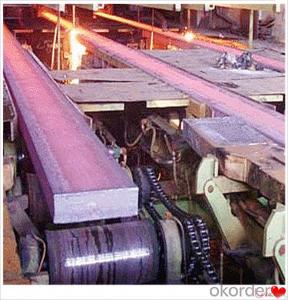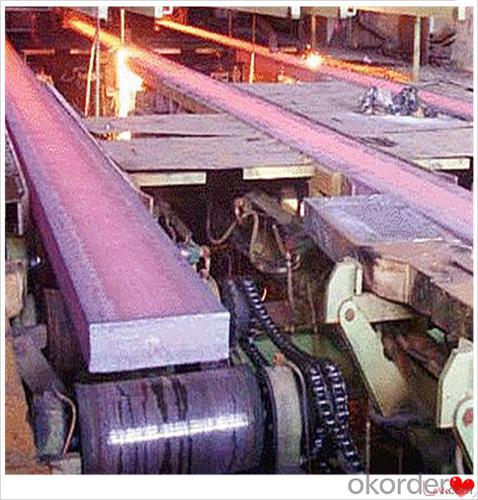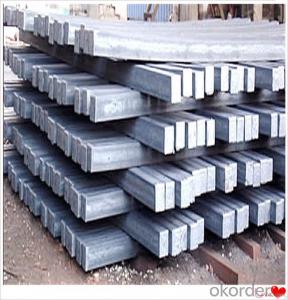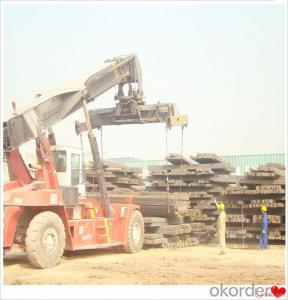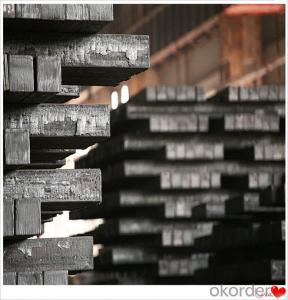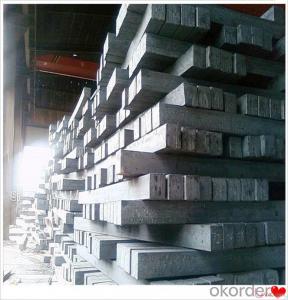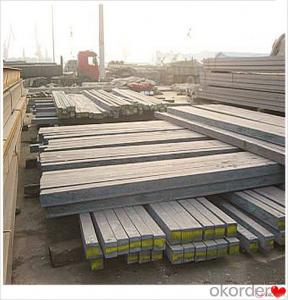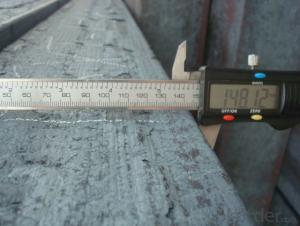5p/Ps Steel Billets Q235,Q255,Q275,Q345,3SP,5SP,20MnSi
- Loading Port:
- China main port
- Payment Terms:
- TT OR LC
- Min Order Qty:
- 20 m.t.
- Supply Capability:
- 200000 m.t./month
OKorder Service Pledge
OKorder Financial Service
You Might Also Like
5p/Ps Steel Billets Q235,Q255,Q275,Q345,3SP,5SP,20MnSi
Specification
Steel billet(ingot) by cogging or breakdown of semi-finished products, is the raw material of all kinds of steel mill. Billet section of square, round, flat, rectangular and abnormity of several kinds of, mainly related to the shape of rolled products.
CNBM Q235,Q275,Q345,3SP,5SP,20MnSi Billets Steel
Hot Rolled Steel Billets/ Mild Steel Bar/ Billet Steel
Specification (see below)
Standard: GB/JIS/ASTM
Size: 50*50mm-180*180mm
Length: 3-12mtrs or Customised
Steel material: Q235,Q255,Q275,Q345,3SP,5SP,20MnSi
Technique: Hot rolled
FOB Unit Ton Price $250-350 and Usually I will quote you CFR price.
MOQ: Usually 1000-10000MT/size
Shipment:By Container,Bulk Vessel
Packaging Details: bundles with steel strips or as customers's requirements
Delivery time: Usually within 30 days after the deposit/LC
Inspection:Third party inspection before loading.
Technical data
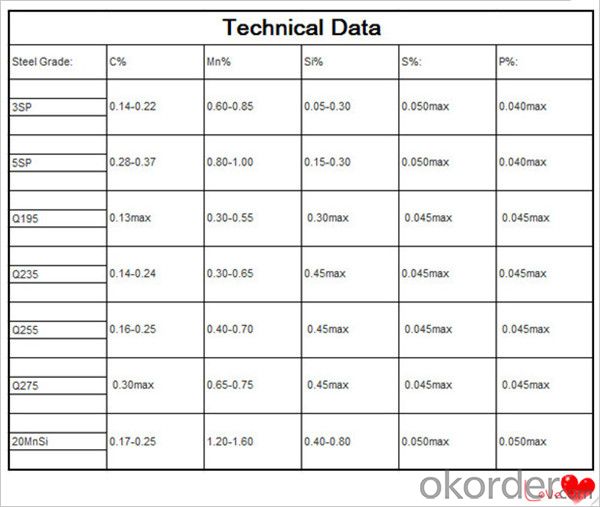
Feature Steel Billet
Rectangular billet continuous casting billet and mainly general carbon steel, low carbon low silicon cold-rolled material, high quality carbon structural steel, high strength low alloy steel, special steel, etc.
The billet is mainly divided into two kinds from the shape:
Slab: cross section width and height of the ratio of the larger, mainly used for rolling plate.
Billet: equal cross section width and height, or a huge difference, mainly used for rolling steel, wire rod. ,
Steel billets have distinct characteristics as compared with already furnished steel bars and products. Billets have a specific grain structure, which enables the metal to be processed more intricately. Steel billets are also known for their malleability and ductility, especially when exposed to varying temperatures during shaping and molding.
Packaging & Shipping
1. Packaging:
1) Small size: in bundles
2)Big size: in bulk
3)in plastic packing or as per customer requirement
2. Delivery time:
1) Normal size: within 7days send from warehouse directly
2) Special size: with 25-30days customer made for you
3. Trade terms:FOB/CFR/CIF
4. Shippment:
1) length:≤5.8m loaded in 20FT Container with 25-27tons
2) length:≤11.8m loaded in 40FT Container with 25-27tons
3) lengnth:≥12m shipped by bulk vessel, FILO terms
Steel Billet Images
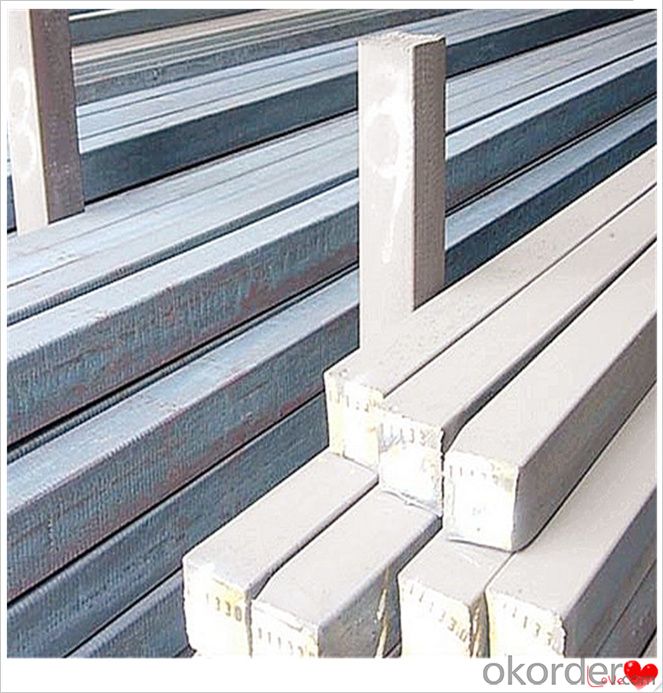
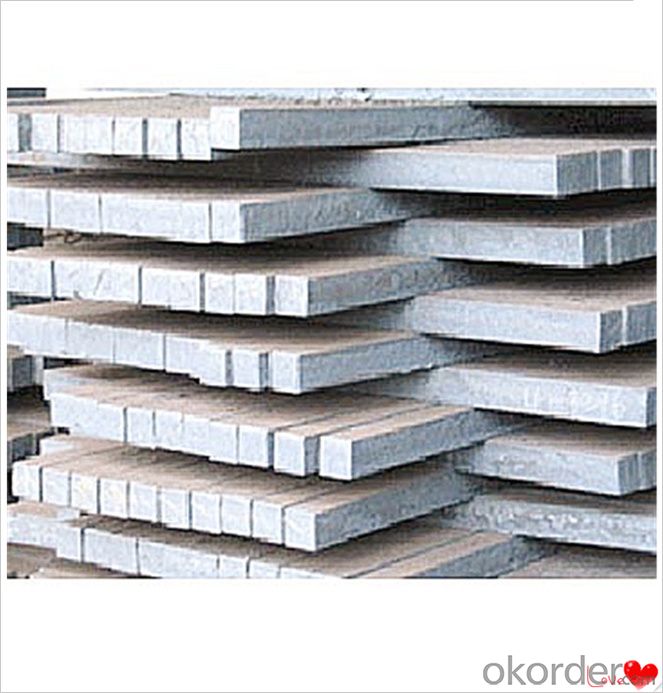
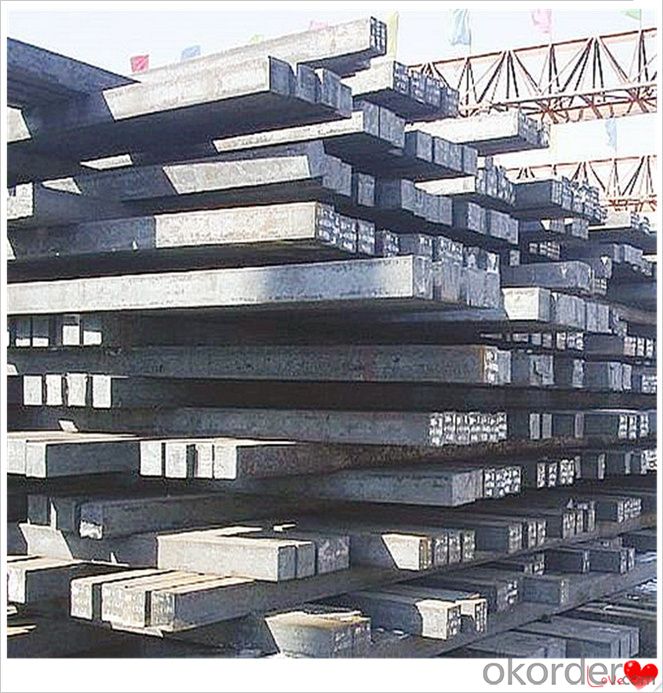
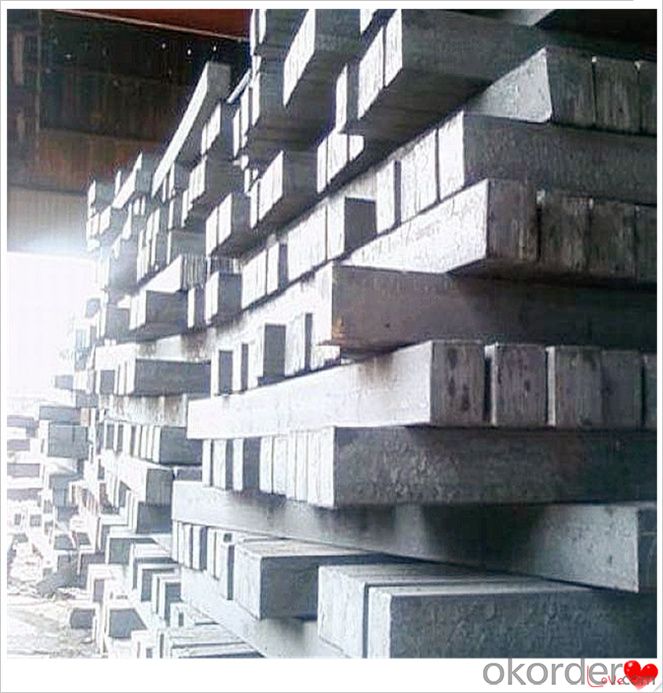
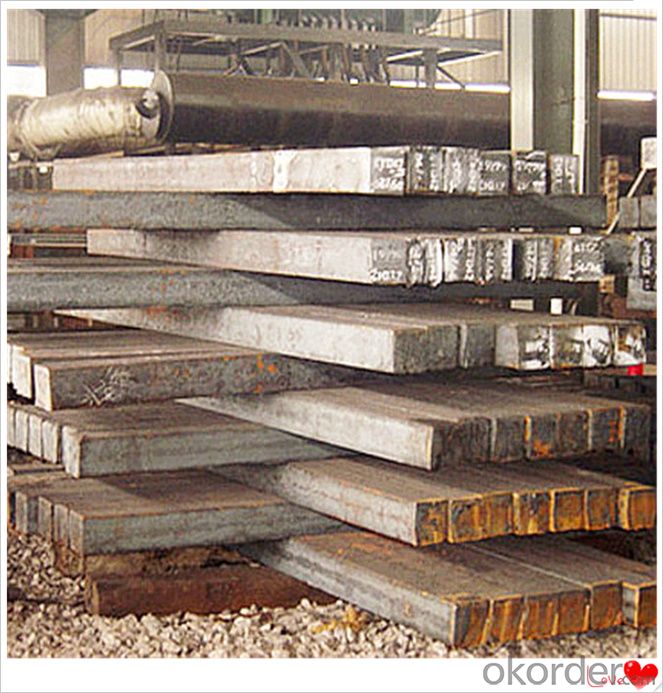
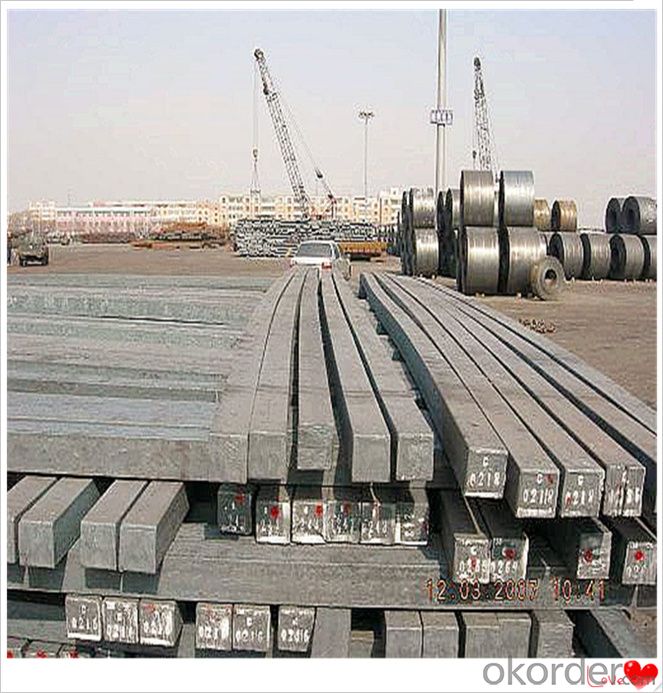
Processing
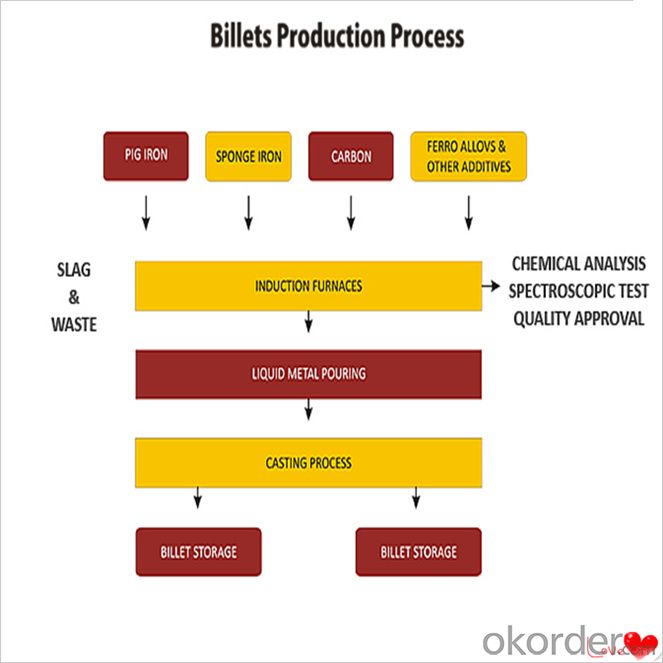
Usage-Billet Steel
Used for the plant, the bridge,shipment building high-rise building construction,lifting and transportation machinery, equipment manufracturing base building the support foundation pile manufacturing.
Billets, or ingots (as they sometimes referred to), are not of practical use until they have been formed into more functional shapes and sizes. While they have already been put in the furnace, they still require a series of shaping and molding procedures such as hot and cold working, milling and cutting before they are sold in hardware stores, or used for different applications. The unformed billets, however, can be used in striking currency such as coins and as reserves, similar to gold bars.
FAQ-Billet Steel
We have organized several common questions for our clients,may help you sincerely:
1) How about your company?
A world class manufacturer & supplier of castings forging in carbon steel and alloy steel,is one of the large-scale professional investment casting production bases in China,consisting of both casting foundry forging and machining factory. Annually more than 8000 tons Precision casting and forging parts are exported to markets in Europe,America and Japan. OEM casting and forging service available according to customer’s requirements.
2) How to guarantee the quality of the products?
We have established the international advanced quality management system,every link from raw material to final product we have strict quality test;We resolutely put an end to unqualified products flowing into the market. At the same time, we will provide necessary follow-up service assurance.
3) How long can we receive the product after purchase?
In the purchase of product within three working days, We will arrange the factory delivery as soon as possible. The pecific time of receiving is related to the state and position of customers.Commonly 7 to 10 working days can be served.
4)Do you have your own QC department?
Yes, we have, our QC department will inspect the goods during the process of mass production and after completion of production.
hot sale!!! Cast Steel Grades/ mild steel bar/ billet steel
(1): High quality steel with reasonable price.
(2): Wide excellent experiences with after-sale service.
(3): Every process will be checked by responsible QC which insures every product's quality.
(4): Professional packing teams which keep every packing safely.
(5): Trial order can be done in one week.
(6): Samples can be provided as your requirements.
- Q: How do steel billets contribute to the strength of a structure?
- Steel billets contribute to the strength of a structure in several ways. Firstly, steel billets are produced by a process called casting, which involves pouring molten steel into molds and allowing it to solidify. This method ensures that the steel billets have a consistent and uniform composition, with minimal impurities. As a result, the structural integrity and strength of the final product are enhanced. Secondly, steel billets undergo a process called hot rolling or cold rolling, which further improves their strength. Hot rolling involves heating the steel billets to high temperatures and then passing them through a series of rollers, which compress and shape the steel into the desired form. This process helps align the steel's grain structure, making it stronger and more resistant to deformation. Additionally, steel billets are often used as raw material for the production of other steel products, such as beams, columns, and plates. These fabricated steel components are then incorporated into structures, providing additional strength and support. The high strength and durability of steel billets make them ideal for withstanding heavy loads, seismic forces, and other external pressures. Moreover, steel billets can be alloyed with other elements, such as carbon, manganese, and chromium, to enhance their mechanical properties and increase their strength. The addition of these alloying elements improves the steel's hardness, toughness, and resistance to corrosion, making it even more suitable for structural applications. Overall, steel billets play a crucial role in enhancing the strength of a structure. Through their uniform composition, hot or cold rolling processes, and alloying capabilities, steel billets contribute to the overall structural integrity, durability, and load-bearing capacity of buildings, bridges, and other infrastructure projects.
- Q: What are the causes of internal cracks in continuous casting billet?
- The test according to the process of the sample for cooling, in order to study the effects of the three elements of the internal crack of continuous casting billet hot.
- Q: What are the different types of steel billet rolling mill defects?
- There are several types of steel billet rolling mill defects that can occur during the rolling process. These defects can have various causes and can affect the quality and performance of the final product. Some of the common types of defects include: 1. Surface defects: These defects are visible on the surface of the rolled billet and can include scratches, cracks, pits, and scale. Surface defects can be caused by improper handling, inadequate lubrication, or excessive rolling pressures. 2. Shape defects: Shape defects refer to the deviations from the desired shape of the billet. These can include bowing, twisting, or excessive tapering. Shape defects can be caused by uneven cooling, improper alignment of the rolling mill, or incorrect rolling parameters. 3. Internal defects: Internal defects are defects that are not visible on the surface but can affect the structural integrity of the billet. These defects can include segregation, porosity, and inclusions. Internal defects can be caused by the presence of impurities in the raw material, improper heating or cooling, or inadequate quality control measures. 4. Dimensional defects: Dimensional defects refer to deviations from the desired dimensions of the billet, such as variations in length, width, or thickness. These defects can be caused by improper calibration of the rolling mill, incorrect rolling parameters, or inadequate quality control measures. 5. Metallurgical defects: Metallurgical defects are defects that occur due to improper metallurgical processes during rolling. These defects can include grain size variations, improper grain flow, or undesirable microstructure. Metallurgical defects can be caused by improper temperature control, inadequate alloying, or insufficient heat treatment. It is important for steel billet rolling mills to have proper quality control measures in place to identify and rectify these defects. Regular inspections, testing, and monitoring of the rolling process can help to minimize these defects and ensure the production of high-quality steel billets.
- Q: How do steel billets contribute to the infrastructure development?
- Steel billets play a crucial role in the infrastructure development due to their versatility and strength. These solid blocks of steel are used as a raw material in the construction of buildings, bridges, and other infrastructure projects. One of the primary ways steel billets contribute to infrastructure development is through the production of reinforced concrete. Steel rebars, which are made from steel billets, are embedded within the concrete to provide additional strength and durability. This reinforcement helps to withstand the forces exerted on the structure, ensuring its long-term stability. Moreover, steel billets are also used in the manufacturing of structural steel sections such as beams, columns, and trusses. These components are essential for constructing various types of infrastructure, including high-rise buildings and bridges. The use of steel in these applications provides excellent load-bearing capacity, allowing for the construction of large and complex structures. Steel billets are also utilized in the production of pipes, which are vital for infrastructure systems like water supply, sewage, and gas pipelines. The strength and corrosion resistance of steel make it an ideal material for these applications, ensuring the integrity and longevity of the infrastructure network. Another significant contribution of steel billets to infrastructure development is in the manufacturing of heavy machinery and equipment used in construction projects. From cranes to excavators, steel billets are used to construct the frames and other structural components of these machines, ensuring their strength and reliability. In summary, steel billets contribute to infrastructure development by providing the necessary strength and durability for various construction applications. Whether it is reinforcing concrete, manufacturing structural components, or constructing heavy machinery, steel billets play a vital role in creating resilient and long-lasting infrastructure.
- Q: How are steel billets used in the production of reinforcement bars?
- Steel billets are the primary raw material used in the production of reinforcement bars. These billets are heated and then passed through a series of rolling mills to shape them into the desired size and shape of reinforcement bars. The rolling process also helps in improving the mechanical properties and strength of the bars. Once the bars are formed, they undergo further processes such as quenching and tempering to enhance their strength and durability. Overall, steel billets play a crucial role in the production of reinforcement bars by serving as the starting material and undergoing various manufacturing processes to produce high-quality bars used in construction and infrastructure projects.
- Q: What is the typical impact strength of a steel billet?
- The impact strength of a steel billet typically varies based on the grade and composition of the steel. Generally, steel billets have a high level of toughness and can endure significant impact forces without fracturing or breaking. This is because steel possesses inherent strength and ductility. Nevertheless, it is important to acknowledge that the impact strength of a steel billet can be further improved through various methods like heat treatment or alloying. These techniques assist in enhancing the material's resistance to impact, making it more durable and suitable for demanding applications. Essentially, to determine the exact impact strength of a steel billet, it is crucial to consider the specific grade and composition. Different steel grades are designed for different purposes, and consequently, their impact strength can vary. Therefore, it is advisable to consult the manufacturer or refer to the material specifications to obtain accurate and detailed information regarding the typical impact strength of a particular steel billet.
- Q: What are the specifications for alloy steel billets used in the defense industry?
- The specifications for alloy steel billets used in the defense industry vary depending on the specific application and requirements of each project. However, there are certain common specifications that are typically followed. Firstly, the alloy steel billets used in the defense industry must meet stringent material standards and be certified to specific military or industry specifications. These standards often include requirements for the chemical composition, mechanical properties, and heat treatment of the alloy steel. The chemical composition of the alloy steel billets is crucial, as it determines the material's strength, hardness, and resistance to corrosion and high temperatures. The specific composition may vary depending on the intended use, but common alloying elements include chromium, molybdenum, vanadium, and nickel. Additionally, the carbon content is carefully controlled to achieve the desired strength and toughness. In terms of mechanical properties, alloy steel billets for defense applications generally need to have high strength, toughness, and impact resistance. They should be able to withstand extreme conditions, including high pressure, shock, and vibrations. The billets may undergo specific heat treatments, such as quenching and tempering, to achieve the desired mechanical properties. The dimensional specifications for alloy steel billets used in the defense industry are also crucial. They must meet precise size and shape tolerances, as well as surface finish requirements, to ensure compatibility with the manufacturing processes and final products. Furthermore, the billets may need to be certified to specific industry or military standards, such as MIL-STD or ASTM specifications, to ensure their suitability and reliability for defense applications. These standards define the testing methods, quality control requirements, and performance criteria that the alloy steel billets must meet. Overall, the specifications for alloy steel billets used in the defense industry encompass a range of factors, including chemical composition, mechanical properties, dimensional tolerances, and adherence to industry or military standards. These specifications are essential to ensure the performance, durability, and safety of the final defense products.
- Q: How are steel billets used in the production of mining machinery?
- Steel billets are used in the production of mining machinery as they serve as the raw material for forging and shaping various components such as gears, shafts, frames, and structural elements. These billets are heated and then formed into desired shapes through processes like rolling, machining, and welding. The high strength and durability of steel make it ideal for withstanding the harsh conditions and heavy loads associated with mining operations, ensuring the reliability and performance of mining machinery.
- Q: Can steel billets be used in the production of energy infrastructure?
- Yes, steel billets can be used in the production of energy infrastructure. Steel is a commonly used material in the construction of power plants, transmission towers, pipelines, and other energy-related structures due to its strength, durability, and resistance to corrosion. Steel billets are the raw form of steel that can be shaped and processed into various components required for energy infrastructure projects.
- Q: How are steel billets used in the manufacturing of pumps and compressors?
- Steel billets are an essential raw material in the manufacturing process of pumps and compressors. These billets, which are essentially semi-finished steel forms, are used to create the various components and parts of pumps and compressors. The first step in utilizing steel billets is to heat them to a high temperature in order to make them malleable and ready for shaping. Once heated, the billets are then subjected to different types of metalworking processes such as forging, rolling, or extrusion. These processes help transform the billets into the desired shapes and sizes required for the specific components of pumps and compressors. In the manufacturing of pumps, for example, steel billets are used to create impellers, which are responsible for the movement and circulation of fluids. The billets are shaped into the required impeller design through machining or casting processes. Similarly, for compressors, steel billets are used to create components such as cylinders, pistons, and connecting rods, which are vital for the compression and movement of gases. The choice of steel billets in pump and compressor manufacturing is driven by their desirable properties such as strength, durability, and resistance to corrosion. These properties are crucial for ensuring the longevity and efficiency of these mechanical devices, especially when they are subjected to high pressures, temperatures, and harsh working conditions. Overall, steel billets play a fundamental role in the manufacturing of pumps and compressors as they provide the necessary raw material for shaping and creating the various components that enable these devices to function effectively.
Send your message to us
5p/Ps Steel Billets Q235,Q255,Q275,Q345,3SP,5SP,20MnSi
- Loading Port:
- China main port
- Payment Terms:
- TT OR LC
- Min Order Qty:
- 20 m.t.
- Supply Capability:
- 200000 m.t./month
OKorder Service Pledge
OKorder Financial Service
Similar products
Hot products
Hot Searches
Related keywords
